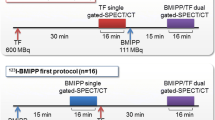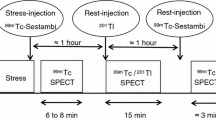Abstract
Dual-isotope single-photon emission tomography (SPET) with indium-111 antimyosin and thallium-201 chloride was performed in 54 patients with acute myocardial infarction (AMI) to detect the location and extent of myocardial necrosis (antimyosin) and viable myocardium (201T1). All patients underwent intravenous thrombolytic therapy with either streptokinase (1.5 million units/90 min) or tissue plasminogen activator (80 mg/90 min). Sensitivity in detecting MI was 91% (49/54 patients). With regard to dual-isotope SPET patterns, patients were devided into three groups: match, i.e. antimyosin uptake in segments with thallium defect (n = 8); mismatch, i.e. no uptake of either of the nuclides in corresponding segments (presence of perfusion abnormalities in the absence of antimyosin uptake) (n = 5); and overlap, i.e. thallium uptake in segments with uptake of antimyosin (n = 41). Coronary angiography and thallium exercise tests were performed in 40 and 45 patients, respectively, 5–14 days after MI. Exercise-induced ischaemia occurred in 66% of patients with overlap, 14% with match and 0% with mismatch (P <0.05 for overlap vs other groups). If, however, major in-hospital complications (sudden cardiac death, severe arrhythmias; five overlap, three overlap in addition to match/mismatch, two match, two mismatch) were included in the statistical analysis, there was no significant difference between the three groups (P = NS). Thus, although the dual-isotope pattern “overlap” identifies a subgroup of patients with a substantial amount of residual viable tissue after MI and a high probability of exercise-induced ischaemia, this criterion is of limited value in assessing short-term prognosis. Nevertheless, in cases of doubt it may help to decide which patients should undergo coronary revascularization.
Similar content being viewed by others
References
ISAM Study Group. A prospective trial of intravenous streptokinase in acute myocardial infarction (ISAM) — mortality, morbidity and infarct size at 21 days. N Engl J Med 1986; 314: 1465–1471.
ISIS-2 (Second International Study of Infarct Survival) Collaborative Group. Randomized trial of intravenous streptokinase, oral aspirin, both, or neither among 17, 187 patients of suspected acute myocardial infarction — ISIS-2. Lancet 1988; 11: 349–360.
Gruppo Italiano per to studio della sopravivenza nell infarto miocardico. GISSI-2: a factorial randomized trial of alteplase vs. streptokinase and heparin vs. no heparin among 12,490 patients with acute myocardial infarction. Lancet 1990; II: 65–71.
Grip L, Ryden L. Late streptokinase infusion and antithrombotic treatment in myocardial infarction reduce subsequent myocardial ischemia. Am Heart J 1991; 121: 737–743.
TIMI Study Group. Comparison of invasive and conservative strategies after treatment with i.v. tissue plasminogen activator in acute myocardial infarction. N Engl J Med 1989; 320: 618–627.
Williams DO, Braunwald E, Knatterud G, et al. and TIMI Investigators. One-year results of the thrombolysis in myocardial infarction investigation (TIMI). Phase II trial. Circulation 1992; 85: 533–542.
Califf RM, Granger C. TIMI IIB follow-up. Lessons for clinicians and investigators. Circulation 1992; 85: 839–841.
Grines CC, Browne KF, Marco J, et al. A comparison of immediate angioplasty with thrombolytic therapy for acute myocardial infarction. N Engl J Med 1993; 328: 673–679.
Zijlstra F, de Boer MJ, Hoorntje ICA, Reiffers S, Reiber JHC, Suryapranata H. A comparison of immediate coronary angioplasty with i.v. streptokinase in acute myocardial infarction. N Engl J Med 1993; 328: 680–684.
Lange RA, Hillis LD. Immediate angioplasty for acute myocardial infarction [editor]. N Engl J Med 1993; 328: 726–727.
Topol EJ, Califf RM, George BS, et al. A randomized trial of immediate vs. delayed elective angioplasty after i.v. tissue plasminogen activator in acute myocardial infarction. N Engl J Med 1987; 317: 581–588.
Khaw BA, Fallon JT, Beller GA, Haber E. Specificity of localization of myosin-specific antibody fragments in experimental myocardial infarction. Histologic, histochemical, autoradiographic and scintigraphic studies. Circulation 1979; 60: 1527–1531.
Khaw BA, Scott J, Fallon JT, Cahill ST, Haber E, Homey C. Myocardial injury: quantification by cell sorting initiated with antimyosin fluorescent spheres. Science 1982; 217: 1050–1053.
Khaw BA, Yasuda T, Gold HK, Leinbach RC, Johns JA, Kanke M, Barlai-Kovach M, Strauss HW Haber E. Acute myocardial infarct imaging with indium-111-labeled monoclonal antimyosin Fab. J Nucl Med 1987; 28: 1671–1678.
Carrio I, Berna L, Ballester M, Estorch M, Obrador D, Cladellas M, Abadal L, Ginjaume M. Indium-111 antimyosin scintigraphy to assess myocardial damage in patients with suspected myocarditis and cardiac rejection. J Nucl Med 1988; 29: 1893–1900.
Dec GW Palacios I, Yasuda T, Fallon JT, Khaw BA, Strauss HW Haber E. Antimyosin antibody cardiac imaging: its role in the diagnosis of myocarditis. J Am Coll Cardiol 1990; 16: 97–104.
Obrador D, Ballester M, Carrio I, Berna L, Pons-Llado G. High prevalence of myocardial monoclonal antimyosin antibody uptake in patients with chronic idiopathic dilated cardiomyopathy. J Am Coll Cardiol 1989; 13: 1289–1293.
Johnson LL, Lerrick KS, Coromilas J, et al. Measurement of infarct size and percentage myocardium infarcted in a dog preparation with single-photon emission computed tomography, thallium-201, and indium-111 monoclonal antimyosin Fab. Circulation 1987; 76: 181–190.
Jain D, Lahiri A, Raftery EB. Immunscintigraphy for detecting acute myocardial infarction without electrocardiographic changes. Brit Med J 1990; 300: 151–153.
Jain D, Lahiri A, Raval U, Raftery EB. Discordance between In-111 antimyosin uptake, regional perfusion and wall motion abnormalities in acute Q-wave myocardial infarction [abstract]. Circulation 1988; 78: Suppl II: 493.
van Vlies B, Baas J, Visser CA, et al. Predictive value of indium-111 antimyosin uptake for improvement of left ventricular wall motion after thrombolysis in acute myocardial infarction. Am J Cardiol 1989; 64: 167–171.
Antunes ML, Tresgallo ME, Seldin DW Bhatia K, Johnson LL. Effect of infarct size measured from antimyosin single photon emission tomography scans on left ventricular remodeling. J Am Coll Cardiol 1991; 18: 1263–1270.
Ballester M, Obrador D, Carrio I, et al. Early postoperative reduction of monoclonal antimyosin antibody uptake is associated with absent rejection-related complications after heart transplantation. Circulation 1992; 85: 61–68.
Johnson LL, Seldin DW Becker LC, et al. Antimyosin imaging in acute transmural myocardial infarctions: results of a multicenter clinical trial. J Am Coll Cardiol 1989; 13: 27–35.
Johnson LL, Seldin DW Keller AM, Wall RM, Bhatia K, Bingham CO, Tresgallo ME. Dual isotope thallium and indium antimyosin SPECT imaging to identify acute infarct patients at further ischemic risk. Circulation 1990; 81: 37–45.
Johnson LL. Dual isotope thallium-201 and indium-111 antimyosin antibody tomographic imaging to identify viable myocardium at further ischemic risk after myocardial infarction. J Nucl Biol Med 1992; 36 Suppl 2: 91–96.
Kennedy JW, Ritchie JL, Davies KB, Fritz JK, Maynard C. Western Washington randomized trial of intracoronary streptokinase in acute myocardial infarction: a 12 month follow-up report. N Engl J Med 1985; 312: 1073–1078.
van der Laarse A, Vermeer F, Hermens WT, et al. Effects of early intracoronary streptokinase on infarct size estimated for cumulative enzyme release and on enzyme release rate: a randomized trial of 533 patients with acute myocardial infarction. Am Hear J 1986; 86: 672–681.
Klein HH, Schubothe M, Nebendahl K, Kreuzer H. Temporal and spatial development of myocardial infarction in porcine hearts without significant collateral flow. Texas Heart Inst 1984; 11: 154–159.
Reimer KA, Lowe JE, Rasmussen MR, Jennings RB. The wavefront phenomenon of ischemic cell death. 1. Myocardial infarct size vs. duration of coronary occlusion in dogs. Circulation 1977; 56: 786–794.
Opie LH. Pathophysiology and biochemistry of ischemia, necrosis, and reperfusion. In: Gersh BJ, Rahimtoola SH, eds. Current topics in cardiology. Acute myocardial infarction, 1st edn. New York: Elsevier; 1991: 49–63.
Senior R, Bhattacharya S, Manspeaker P, Liu XJ, Leppo JA, Lahiri A. Tc-99m antimyosin antibody imaging for the detection of acute myocardial infarction in human beings. Am Heart J 1993; 126: 536–542.
Knapp WH, Schmidt U, Notahamiprodjo G, Vystak K, Faß-bender D. In-111 antimyosin antibodies and Tc-99m-MIBI for the assessment of post-infarction myocardial viability [abstract]. J Nucl Med 1989; 30: 800.
Bonow RO, Dilsizian V, Cuocole A, Bacharach SL. Identification of viable myocardium in patients with chronic coronary artery disease and left ventricular dysfunction. Comparison of thallium scintigraphy with reinjection and PET imaging with F-18-fluorodeoxyglucose. Circulation 1991; 83: 26–37.
Brunken R, Schwaiger M, Grower-McKay M, Phelps M, Tillsch J, Schelberg H. Positron emission tomography detects tissue metabolic activity in myocardial segments of patients with persistent thallium perfusion defects. J Am Coll Cardiol 1987; 10: 557–567.
Cloninger KG, DePuey EG, Garcia EV Incomplete redistribution in delayed TI-201 single photon emission computed tomography (SPECT) images: an overestimation of myocardial scarring. J Am Coll Cardiol 1988; 12: 955–963.
Dilsizian V, Rocco TP, Freedman NMT, Leon MB, Bonow RO. Enhanced detection of ischemic but viable myocardium by the reinjection of thallium after stress-redistribution imaging. N Engl J Med 323; 1990: 141–146.
Dilsizian V, Freedmann NMT, Bacharach SL, Perrone-Fillardi P, Bonow RO. Regional thallium uptake in irreversible defects. Magnitude of change in thallium activity after reinjection distinguishes viable from nonviable myocardium. Circulation 1992; 85: 627–634.
Tamaki N, Ohtani H, Yonekura Y, et al. Significance of fill-in after delayed TI-201 reinjection following delayed imaging: comparison with regional wall motion and angiographic findings. J Nucl Med 1990; 31: 1617–1623.
Tamaki N, Ohtani H, Yamashita K, et al. Metabolic activity in the areas of new fill-in after Tl-201 reinjection: comparison with PET using F-18-deoxyglucose. J Nucl Med 1991; 32: 673–678.
Bonow RO, Dilsizian V. Assessing viable myocardium with thallium-201. Am J Cardiol 1992; 70: 10E–17E.
Schöder H, Friedrich M, Topp H. Myocardial viability — what do we need? Eur J Nucl Med 1993; 20: 792–803.
Tamaki N, Yamada T, Matsumori A, et al. In-111 antimyosin antibody imaging for detecting different stages of myocardial infarction: comparison with Tc-99m pyrophosphate imaging. J Nucl Med 1990; 31: 136–142.
Author information
Authors and Affiliations
Rights and permissions
About this article
Cite this article
Schoeder, H., Topp, H., Friedrich, M. et al. Thallium and indium antimyosin dual-isotope single-photon emission tomography in acute myocardial infarction to identify patients at further ischaemic risk. Eur J Nucl Med 21, 415–422 (1994). https://doi.org/10.1007/BF00171416
Received:
Revised:
Issue Date:
DOI: https://doi.org/10.1007/BF00171416




